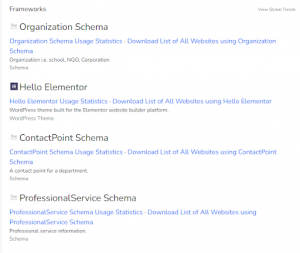Structured data, also known as Schema or rich snippets, is a way of adding specific code to a website’s HTML to help search engines understand the content of a page. This process allows search engines to display relevant information in the search results shown as rich snippets, which are additional pieces of information displayed underneath the link on the search page.
Structured data has become an essential component of search engine optimization (SEO). It can improve the visibility of individual web pages versus others as they appear on a search results page. The overall goal of structured data is to foster a better click-through rate for a web page by giving your target audience more information about what’s on the page.
Look at some frequently asked questions about structured data and how it can help with your SEO.
What is structured data?
Structured data offers a simple platform that adds specific code to a website’s HTML to assist search engines in understanding the content of a page. It uses a standardized format to describe the content, making it easier for search engines to crawl and index the site. This information can then be used to display rich snippets in the search results.
For example, you can add very simple lines of code that tell Google you have a local business, its hours, location, any reviews, and a news article or FAQ page.
What are rich snippets?
Rich snippets represent what Google displays on a search page after the structured data is added to your website’s code. They look like small pieces of information displayed directly underneath or alongside a page’s search results. They can include information such as reviews, ratings, prices, and other relevant data.
Rich snippets can make a website stand out in the search results and increase the click-through rate. Increasing the click-through rate could get your page rank higher in a Google search.
How does structured data help with SEO?
Structured data could assist with SEO in several ways.
1) Structured data makes it easier for search engines to understand the content of a page. That can improve the chances of the page ranking for relevant keywords. For example, you have a dentist’s office in St. Louis. Having local business structured data on the home page can tell Google who would be interested in your services.
2) Rich snippets may improve the visibility and click-through rate of a web page. Indirectly, this exposure might bump your page rank higher in a search.
3) Structured data optimizes certain aspects of the page for voice searches. Voice assistants, like Siri and Alexa, would read these rich snippets. A great example of this is a list of ingredients for a recipe. You can tell your phone what the ingredients are as you shop at the supermarket, giving you a convenient, hands-free experience.
What types of structured data are there?
You have many types of structured data you can add to a website, including:
- Product information, including the name, price, and availability of a product.
- Recipe details, like ingredients, cooking time, and nutrition information.
- Events, including the date, time, and location.
- Local business information so people can find you, like the address, phone number, and hours of operation.
- Article details, such as the headline, author, and publication date.
What do rich snippets look like in a search result?
Rich snippets are often synonymous with structured data. There is one key difference. Rich snippets are the result of structured data. Much like the HTML coding on your website needs to be translated to visual elements on a page, structured data is translated by Google into rich snippets.
See what some of these look like:
Recipes

This screenshot from a Google search results page shows structured data with star ratings, recipe time, ingredients, and the blue links under the top recipe all appear due to structured data set up on the backend of those web pages. Otherwise, they would just appear as a single link in a search result.
Aggregate Rating

Aggregate ratings are important to companies where people choose products or services based on reviews from people who have interacted with a brand. The stars below the main description appear there due to structured data. The goal, of course, is to try to get someone to click on that page because they are highly rated.
FAQ

FAQ Schema shows answers to the first two questions in a series of FAQs posted to a web page. Often, it will answer the two most relevant questions. It will also assist someone in determining if they still need more information ahead of clicking on the link to see answers to more questions.
Do I need to add structured data to my website?
Adding structured data to the coding of your website is not a requirement. However, it can help improve the visibility and click-through rate of individual web pages after they appear in search results. The key is to add the correct structured data to various pages.
How do I add structured data to my website?
There are several ways to add structured data to a website.
Plugin or extension. Tools like these are the easiest way to add elements of Schema to your website. Plugins come in free versions or paid versions. As you can imagine, the paid or pro versions of plugins have better functionality. The main advantage of plugins or extensions for your website is the ease of use across many pages at a time, whether you’ve got 10 pages or 10,000. Plugins are advantageous for making changes en masse and if you have a large website.
Structured data generator. If you want to add code to only a few pages (say, less than 10), a structured data generator works well. This type of tool balances manual input with a rudimentary automated tool. Google has its own version that lets you generate HTML ahead of adding it to the backend of your website. But you still need to add the code manually to your site.
Manually to the HTML code. If you have some coding experience, you can manually add code (Google prefers JSON-LD data) to the back end of your site. Luckily,
How do I know structured data was added correctly to my website?
Google provides a Structured Data Testing Tool that can be used to test the structured data on a website and ensure that it is properly formatted. You can also find out what pages on your website have structured data through Google Search Console under the Enhancements section on the left side of the screen. There is one limitation to the Enhancements section, however. It does not show all of the possible Schema you can set on a page, such as reviews, aggregate reviews, and local business/organization.
Another way to determine if Schema is on your website correctly is through builtwith.com. After Google registers Schema on your site, which can take up to eight weeks, consider entering your domain name into builtwith.com to see if results appear similar to this:

Ready to Elevate Your Website’s User Experience?
Schema, structured data, and rich snippets might improve your website’s user experience before anyone even clicks on a page. Your web page can stand out in Google search results pages, allowing you to connect with your target audience right away.
Having an expert partner will help you implement Schema on your website to stand out from the crowd. Contact us or call (417) 799-2233 for a consultation.





